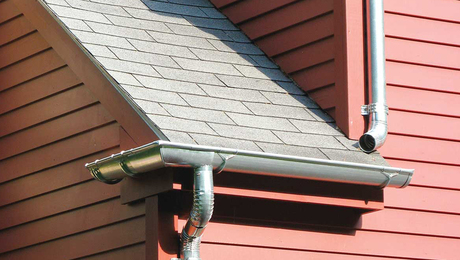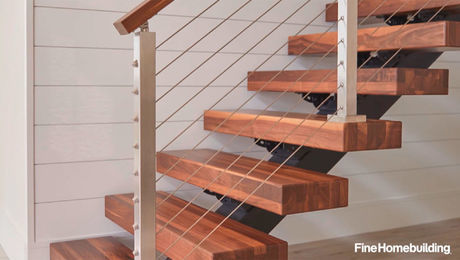Any reason to replace 30yr. old “romex”?
I’m remodeling my typical 1979 single-story subdivision southern California home.
I have the walls open and am doing a lot of work on the wiring. Actually, I’m also undoing a lot of the insanely dangerous work the original owner did on the wiring. I’m carefully inspecting all of the wiring for damage/modfications.
The wiring in the home is romex-style copper and almost 30 years old. Other than the sheathing yellowing and being dirty (some of the sheathing is black, so there’s no yellowing), the sheathing, and the insulation on the indvidual wires, appear fine.
I notice that the new Romex wiring I’m using, while the same gauges, is much smaller in it’s outer dimensions (including the sheathing; not the conductors themselves). I’m sure the sheathing and insulation used is the difference, and I’m sure it’s light years ahead in terms of quality.
My questions are:
Since I’m having to redo so much of the wiring, does it make sense to go to the additional trouble and expense of replacing all of the original wiring? Or, given that that the sheathing and insulation is fine, would that just be wasteful?
I mean, the wiring is almost 30 yrs. old, and I plan to keep the house for at least another 40. Is the original wiring going to somehow wear out or become unsafe in that time?
Replacing all of the wiring would involve the extra expense of the wiring and pulling romex through the attic in a garage with a drywalled ceiling. Not a terrible amount of trouble, but it will take some time.



















Replies
30 YR NM is "modern" with a ground etc. The only difference is that as you have noticed the uses a new thinner, but higher tempature rated insulation.
It is labeled NM-B vs MN.
The only place that this comes into play is that new fixture require high tempature rated wiring in the box.
I would replace those going to ceiling light fixtures. And if you are in a exposed attic and don't expect to finish it you don't even need to replace the whole run. Just install a junction box that will stay accessable near by and run a short loop of new NM-B.
You know your life style, but I would replace the ceiling boxes with fan rated boxes and run 3 wire cable to the switch boxes so that you can independtly control fan and light.
I like ceiling fans. If you don't there is no need to do this.
And while you are at it this is the time to look at those places where there is never enough receptacles in the right place and may move/add light boxes in the bathroom for different fixtures.
.
A-holes. Hey every group has to have one. And I have been elected to be the one. I should make that my tagline.
Ask an electrician in South Los Angeles and he will tell little old ladies, they need to change it all. He will not get a permit and will only change some of it. I have seen this a few times.
A California earthquake can hurt your electrical, but only after it knocks the whole house down.
Thanks for the replies, although I don't think I know what you mean, Sungod.
I mention So Cal only because I usually try to include a few facts about my home when I post a question about working on it. I didn't think earthquakes would affect wiring.
Normally when someone is going to rewire the house by themselves, they would easily have enough experience or knowledge to determine if old romex is good or not. I have only gotten little old ladies who are being gypped ask that question.
If you are working on the wiring, hopefully you know how to balance a circuit, which wire goes on the colored screw, how to wire on a double pole breaker, how to fold wire into a box, twist wire together before installing the wirenut, etc.
We can help you here, but its limited, because we are not there looking over your shoulder to get the full picture. Have someone visit you to give you good advice.
Sungod--
I've rewired another house already, but it was much, much older. The wiring in it obviously needed replacing.
I know a lot about wiring. I know more than enough to wire this house. My only question was regarding replacing the Romex. I think I gave a pretty detailed description of it and asked, based on that description, if I should even be considering replacing it. I'm sure it is safe and well within its lifespan. I only wanted opinions as to whether I should replace it given my specific circumstances. For instance, if newer Romex adds something worth the swap.
Your post is written as though I've asked some really basic, dumb questions. That is not the case. I'm looking for opinions on a very specific matter here, and I've given the details that are necessary to tell me whether it is a consideration. I don't understand why there is always someone who wants to be belligerent.
JDLee,
well to put things into perspective I'm reusing some of my 25+year old wiring after remodeling my house.. I won't reuse the ends because if there is any fatique that's where it is. However, If you haven't moved your wires there should be no fatique in them (assuming they are solid copper and not aluminum which should be replaced)..
IMHO
Thanks. Based on the replies so far (and what I've read elsewhere), I think I'll replace all of the wire in the walls that I have open because I'm already adding so many receptacles. I'm not going to open walls just to replace wire, and if the stuff in the attic looks okay, I guess I'll leave it for now. I agree about cutting stuff off near the ends in case it's fatigued.
Romex should be good for 100 years or so -- 30 years old is a veritable babe in arms. The only issues would be if you had aluminum or if you had some old ungrounded stuff, but you'd have to go back at least another 5 years for AL and about 20 for ungrounded.
If you have any "backstabbed" switches or outlets, though, they should be replaced with "spec grade" backwired units.
EXACTLY what Dan said,
senior EEs usually do agree on the very basic stuff.
One thing I haven't seen the others mention is the effect on the cost of homeowners insurance. Here in Virginia, my insurance company, State Farm, used to apply a surcharge to houses older than 30 years for aging plumbing & wiring. They revised that & now give a rather significant discount if you have replaced the plumbing & wiring. When doing some remodeling, I called to find out exactly what had to be replaced, the response was "everything". If you're gutting the house to the point that it's reasonable to replace it all, you might want to check with your insurance company to see if potential discounts make it worth your time.
Yeah, I'm wondering what State Farm will say in 5 years when my house is 40 YO.
Pile of BS to me.
However; in 1994, did redo a rental built in '74, lots of wrapped and taped connections, not even soldered. Part of a subdivision so pretty sure it had a 'permit', always wondered how that #### passed any inspection if any (WA state). Found 3 open grounds in the house and one outlet wired black to white.
I would add that if the wiring has the now undersized ground wire, it might be good idea to replace that wiring.
I have seen some where the ground wire is a much smaller guage, and have wondered if it is safe. Someone with more technical expertise will chime in on that point.
Another thing to check is that you do have a solid ground. I have seen where probably a diy or hack has installed wiring with a ground wire, but cut the ground wire off or not interconnected all of them properly, so that there is not a good ground connection. Hence, it would likely be unsafe if the ground was needed for a fault situation.
Bryan
"Objects in mirror appear closer than they are."
Klakamp Construction, Findlay, Ohio - just south of the Glass City
Wire that's only 30 years old will have a standard sized ground. The only difference from modern romex is that it'll be NM instead of (higher temp rating) NMB. This is only relevant around ceiling fixtures.
If your view never changes you're following the wrong leader
Thanks!
I must have run across some older than that wire.
Is there a problem with wire that has the under-sized ground?"Objects in mirror appear closer than they are."
Klakamp Construction, Findlay, Ohio - just south of the Glass City
There's no real problem with the wire with undersized ground. It met code at the time and the ground is still big enough to trip the breaker on a short. It would just tend to overheat if the ground were overloaded just short of tripping, something that practically never happens unless a jackleg miswires something.My recollection/impression is that the undersized ground was probably used from maybe 1940 to 1960.
If your view never changes you're following the wrong leader
"My recollection/impression is that the undersized ground was probably used from maybe 1940 to 1960."Apparently a little later than that. My tract, built in 1965, has 12-2 NM with 16ga ground. Ground wires were separated out where the NM enters the metal boxes, wrapped outside of the boxes to the front and clipped to the edge of the box.BruceT
1965 would be about the latest. My parents' home, built in 1966, had full-sized grounds & 3-prong outlets.Of course, code adoption varies by region, and some sparkys may use old stock for years after the new stuff comes out, especially if they can save a penny.
If your view never changes you're following the wrong leader
Thanks for the info."Objects in mirror appear closer than they are."
Klakamp Construction, Findlay, Ohio - just south of the Glass City
So no one answered his question, it is a good question: Is the original wiring going to somehow wear out or become unsafe in that time?
I assume (#### of u & me) it is the resistance of the wire for a given length and gauge?
I have seen wire which looked good, but judging from the surrounding materials had overheated, damaging (?) it's insulation (see pic, sorry about the high resolution), that I would replace, but this isn't always obvious, so how do you know?
Wire a week old can be abused. The wire itself does not "wear out". The copper will last essentially forever if not flexed too much. The insulation will last as long as plastic lasts, which is pretty darn long when kept away from UV light, ozone, oil, and extreme heat. If exposed to such hazards the outer insulation shell will craze and crack long before the individual conductor insulation is compromised, so there's a good "canary" indicator of a problem.Older insulation, prior to roughly 1950, was often either rubber, asphalt, or wax/cloth based, and would tend to deteriorate much more rapidly.
If your view never changes you're following the wrong leader
Re your picture, it appears to me that the darkening is due to moisture or oil from somewhere. What evidence do you have of overheating?
If your view never changes you're following the wrong leader
I think the staining was from the overheating in the wire, the stain iether came from the integral vapour barrier wrapper or from the wire insulation wrapping, both were tar/wax impregnated .. if it was from the wire, then the wire's insulation would have reduced, but to what point, I am pretty sure I have read general guidlines for assessing the condition of wire, I thought it may have had to do with resistance, both on, and between the individual wires within. I think the pic was a fire waiting to happen, no way of knowing what was on that circuit ..
If the stains were due to the wire overheating I'd expect to see the stain the entire length that it contacted with the insulation, and not so much of a "puddle" pattern. Looks more to me like water got onto (or maybe into) the wire and followed it along to those spots.In any event, from the look of this wire it appears to be cloth-covered, not modern plastic-covered romex.
If your view never changes you're following the wrong leader